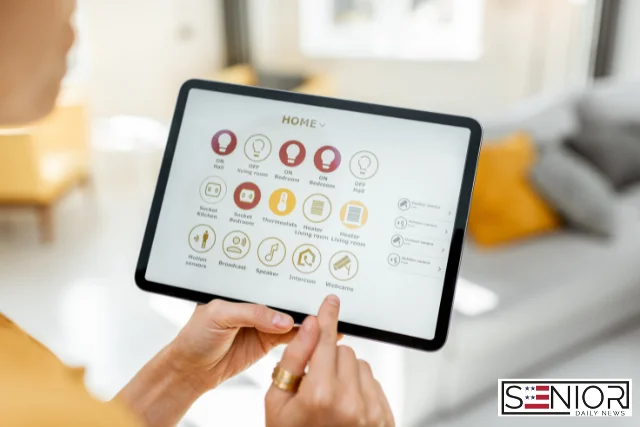Cybersecurity for Your Smart Home Network: A Guide for Seniors

Technology has come a long way, making our homes smarter, more connected, and more convenient than ever before. From voice assistants like Alexa and Google Home to smart thermostats, cameras, lights, and even refrigerators, our homes are rapidly becoming digital hubs. But with this convenience comes a new responsibility: keeping our smart home networks secure.
If you’re a senior citizen in the United States navigating this new world of smart devices, don’t worry. You don’t need to be a tech expert to stay safe. In this guide, we’ll break down cybersecurity for your smart home in simple, practical terms—and help you take steps to protect your privacy and peace of mind.
What Is a Smart Home Network?
A smart home network is a system of internet-connected devices in your home that communicate with each other—and with you—via your Wi-Fi connection. These devices may include:
- Smart TVs
- Security cameras and doorbells
- Smart plugs and light bulbs
- Smart thermostats
- Voice assistants like Amazon Echo or Google Nest
- Health monitoring devices
Many seniors find these devices helpful for improving safety, accessibility, and daily convenience. However, without proper cybersecurity, these same tools can open doors for hackers to access your private information or even take control of your devices.
Why Cybersecurity Matters—Especially for Seniors
Older adults are often targeted by cybercriminals because they may be less familiar with the latest digital threats. A compromised smart home network could lead to identity theft, financial loss, or even physical security risks if smart locks or cameras are involved.
Being proactive about cybersecurity can help you:
- Protect your personal data (name, address, credit cards, Social Security number)
- Prevent unauthorized access to your home devices
- Avoid scams and frauds
- Keep your devices functioning properly
Top Cybersecurity Tips for Smart Home Safety
1. Secure Your Wi-Fi Network
Your Wi-Fi network is the backbone of your smart home. If it’s not secure, everything connected to it is at risk.
- Change the default name (SSID) of your Wi-Fi network. Avoid using your name or address in the name.
- Use a strong password for your Wi-Fi—something unique, long, and hard to guess.
- Use WPA3 encryption if available (or WPA2 at minimum).
- Disable remote access unless you really need it.
2. Use Strong, Unique Passwords for Each Device
Don’t keep the factory-default passwords that come with smart devices. These are easy for hackers to guess. Instead:
- Create strong, unique passwords for each device and account.
- Consider using a password manager to keep track of them securely.
3. Keep Your Devices Updated
Just like your phone or computer, smart devices need regular updates.
- Enable automatic updates where possible.
- Check manufacturer websites or app settings for firmware updates.
4. Set Up a Guest Network
Most modern routers allow you to create a separate guest Wi-Fi network.
- Use your main network for your personal devices.
- Let visitors use the guest network so they don’t have access to your smart home controls.
5. Enable Two-Factor Authentication (2FA)
Many apps and devices now support 2FA, which adds an extra layer of security.
- When logging in, you’ll need your password and a code sent to your phone or email.
- This makes it much harder for hackers to get in.
6. Monitor Your Devices Regularly
Keep an eye on which devices are connected to your network.
- Use your router’s app or control panel to check.
- If you see anything unfamiliar, disconnect it and change your password immediately.
7. Be Wary of Phishing Scams
Cybercriminals often use fake emails, calls, or texts to trick you into giving up personal information.
- Never click links from unknown sources.
- Don’t share passwords or Social Security numbers over email or phone.
- If in doubt, ask a family member or trusted friend.
Recommended Smart Devices with Strong Security Features
If you’re a new pet owner looking for pet health checklist devices—or a senior using health monitoring gadgets—it’s worth choosing products with built-in security. Here are some that are well-reviewed for security:
- Amazon Echo with Guard – Monitors for glass breaking and alarms.
- Nest Protect Smoke and CO Detector – Sends alerts to your phone.
- Wyze Cam with 2FA – Affordable smart camera with encrypted storage.
- Fitbit or Apple Watch – Secure health tracking options.
Helpful Tools and Resources
- Router Management Apps (e.g., Netgear Nighthawk, TP-Link Tether): Help you view and manage devices on your network.
- Password Managers (e.g., LastPass, 1Password): Store and generate strong passwords.
- Antivirus Software (e.g., Norton, Bitdefender): Protects your phone or computer from malicious threats.
Empowering Yourself Through Education
Cybersecurity doesn’t have to be intimidating. Many community centers and libraries offer free digital literacy classes specifically for seniors. Ask a younger family member to help you understand your setup, or find online tutorials tailored to beginners.
Even a small step—like updating your router’s password—can have a big impact.
FAQs
Q: Are smart home devices really safe to use? A: Yes, as long as you take basic precautions like updating devices, using strong passwords, and securing your Wi-Fi, smart devices are generally safe and can enhance your home’s convenience and safety.
Q: How do I know if someone has hacked into my smart home? A: Signs may include strange behavior from devices, unknown devices on your network, or notifications of login attempts. If you suspect a breach, change your passwords and consult a tech-savvy friend or professional.
Q: What’s the best router for smart home security? A: Look for routers with WPA3 encryption, automatic updates, and the ability to set up guest networks. Popular options include Netgear Nighthawk, TP-Link Archer series, and Google Nest WiFi.
Q: Do I need antivirus software for my smart devices? A: While most smart devices don’t support traditional antivirus, it’s smart to protect your phone and computer with antivirus software, as these are often the main control points for smart devices.
Q: Can I turn off devices when I’m not using them? A: Yes! Turning off or unplugging devices when not in use can reduce exposure to cyber threats and save energy.
Image Designed Using Canva






